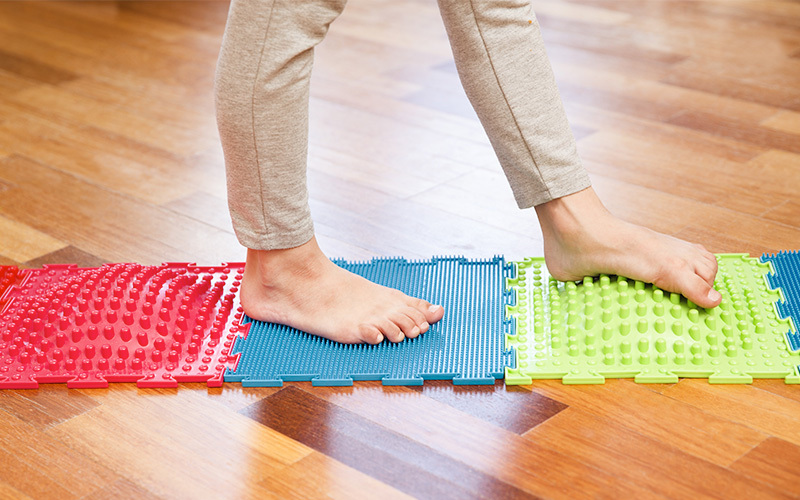A minimally invasive surgical option for children with flexible flatfoot

Most children with flexible flatfoot, a common condition in which arches do not develop in the feet, don’t need surgery, or any medical intervention at all. The few who do need surgery typically face a complicated procedure and a long recovery.

Children in many parts of Europe, however, have another option. A minimally invasive procedure, subtalar extra-articular screw arthroereisis (SESA), has been practiced there for several decades and is now practiced at Boston Children’s Hospital as well. Compared to traditional flatfoot surgery, recovery from the SESA procedure is much quicker and less painful.
Dr. Susan Mahan, an orthopedic surgeon in the Lower Extremity Program at Boston Children’s, travelled to Italy in 2018 to learn the procedure. Since then, she has used the SESA surgery to correct over thirty different patients’ flexible flatfoot. Currently, Boston Children’s is one of the only hospitals in the U.S. or Canada to offer this procedure.
Here, Dr. Mahan talks about the minimally invasive SESA surgery and which patients may benefit.
When is surgery an option for flexible flatfoot?
Most kids with symptomatic flexible flatfoot don’t need surgery. Physical therapy, stretching, shoe inserts, or some combination of these will resolve their pain. I only recommend surgery for children who continue to be in pain despite conservative treatments. Even then, surgery is usually only appropriate after a child’s foot has fully developed, around age 8 or 10.
What is the traditional surgical approach for flexible flatfoot?
Before now, the only surgical option for flexible flatfoot in the U.S. has been full foot reconstruction. The procedure, which can take four to five hours, involves cutting bones in the foot and reorienting them. Patients can’t put weight on their foot for several months afterwards, and full recovery takes a good six months.
How does SESA surgery work?
For this procedure, I make a small incision near the ankle and place a SESA screw next to the joint. The screw stabilizes the foot and acts as a mechanical barrier, preventing the bones from returning to a flat position. Within three years, the screw is no longer needed and can be removed.
How long does minimally invasive flatfoot surgery take?
This depends on whether or not a patient’s Achilles tendon also needs to be lengthened. If the Achilles is not tight, patients are in and out of the operating room in about one hour. If I need to lengthen a patient’s Achilles tendon, the surgery takes an additional 30 minutes.
How long is the recovery from minimally invasive flatfoot surgery?
This also depends on whether the Achilles tendon needs to be lengthened. Patients who only need a SESA screw are typically able to walk without crutches in less than a week. They have to take about a month off from sports until I know they’re walking well.
If a patient’s Achilles tendon is lengthened, it will take more time to heal. These patients typically wear a walking cast for a month and then transition to a boot and physical therapy. Most can return to sports within a couple of months.
In either case, the child’s foot may get tired and achy for the first few months after surgery. This is normal — the muscles in their foot have to adjust to having an arch — and gets better over time.
Are there any patients for whom foot reconstruction is a better option than SESA surgery?
A small number of patients with severe or rigid deformity will still need reconstructive surgery. However, the minimally invasive option is perfectly sufficient for many patients.
How have patients and families responded to the SESA procedure?
Most families, after hearing about minimally invasive surgery and full foot reconstruction, decide to try the minimally invasive surgery. The shorter recovery time is very appealing, particularly in early adolescents.
Another nice thing about this procedure is it doesn’t change the foot in a way that would make foot reconstruction impossible in the future. So far, none of our patients have needed full foot reconstruction after a SESA procedure. However, if the minimally invasive surgery doesn’t work, that option remains open.
Learn more about the Lower Extremity Program or call for an appointment.
Related Posts :
-

Innovative flatfoot surgery releases Quinn's inner athlete
By the time he was 10, Quinn’s parents had tried almost everything. Dawn would sometimes massage his feet to ...
-

A new option for teens with painful bunions
Bunions, bumps at the base of the big toes, are probably not at the top of most kids’ list of ...
-

One family, two very different clubfoot experiences
Theresah Boateng and her daughter Eno Agyapomaa Agyemang both have strong wills and outgoing personalities. Both were born with a ...
-

Diagnosed with clubfeet before he was born: Gabriel’s story
Cheryl Bratt and her wife, Sue, expected a routine visit when they went in for their 18-week ultrasound. Cheryl, a ...





